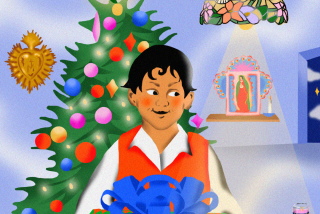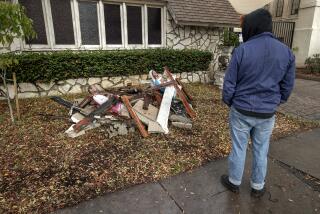Reliving Religious Drama in O.C.
- Share via
FULLERTON — That’s entertainment?
Following ancient religious tradition, 19th-Century Roman Catholics living in the American Southwest observed Holy Week--the days preceding Easter--through theatrical re-enactments of Christ’s suffering and crucifixion. Life-size wooden figures with movable limbs starred in Passion plays.
“People didn’t have stereos and TVs, and this was high drama,” says Kathy Reynolds, an authority on art of the era. “Witnessing this was a highlight of their spiritual practice, a crescendo for the Catholic Hispanic community.”
A large traveling exhibit of these spare, powerful santos (Spanish for “holy images”) opens at Fullerton Museum Center today, offering a glimpse into the deeply pious culture of colonial New Mexico and southern Colorado, where life often revolved around the Catholic faith.
About 120 pieces (most from 1830 to 1930) make up “Santos: Images of Penance, Images of Mercy,” which features santos de retablo, or paintings, and santos de bulto, the three-dimensional figures, from a foot tall to life-size. Both were reminders of one’s mortality or the ultimate goal of salvation of the soul, and depicted saints or holy people. No church or home was without them.
“Most people had favorite saints to whom they appealed for certain causes,” from relief of pain to forgiveness, Reynolds said in a recent interview at the museum center. She is traveling-exhibitions curator for the Taylor Museum for Southwestern Studies of the Colorado Springs Fine Arts Center in Colorado, which created the exhibit from its later-period Southwestern santos collection, one of the country’s largest.
Some early santos may have been made by American Indians, Reynolds said, but most were crafted by Mexican and Spanish colonists. Initially influenced by artistically trained Franciscan priests painting in a formal medieval or Renaissance style, the colonists developed their own unique style--a more simplistic, folk art tradition--after the Franciscans left the area in the early 1830s.
On view here are several santos de bulto of Our Lady of Solitude--the Virgin Mary after the Crucifixion, her pale, oval face wracked with loss and sorrow; Death, shrouded in an ominous black cape, and Jesus Nazarene, his eyes downcast, blood trickling from his crown of thorns and from the nail holes in his hands and feet.
Many such statues , carved from wood and painted, have articulated shoulders, elbows, knees, jaws or necks so they could assume different poses to fit sections of a Holy Week procession, during which a Christ bulto could be crucified, taken down from the cross, then placed in a sepulcher. The ceremonials meant a great deal to rural villagers, particularly those who could not read and benefited from the visual aid.
Reynolds hopes the exhibit helps clear up misconceptions that such re-enactments are “grisly, gruesome” rituals. They did involve flagellation and other forms of self-mortification but were performed by a Catholic lay organization known today as the Brotherhood of Our Father Jesus Nazarene (popularly, the Penitentes), fervently dedicated to preserving Spanish culture and to penitence, hence the predominance of santos associated with Christ’s suffering.
“It’s important that people understand that the Brotherhood’s objectives were and are to love and serve the community and venerate Christ,” she said. “The whole premise (of the exhibit) is to sensitively interpret this spiritual aspect, as well as the culture that produced it.”
The 19th-Century santeros, or santos makers, were also highly religious people (all men, though some today are women), Reynolds said. In fact, she does not describe them as artisans or folk artists but as followers of a spiritual calling and said they were supposed to have “received” the images for santos from inner spiritual inspiration and preferred anonymity.
“ Santos were made for the glory of God, not for man’s glory,” she said.
“Santos: Images of Penance, Images of Mercy,” through Aug. 30 at the Fullerton Museum Center, 301 N. Pomona Ave., Fullerton. Sante Fe santos maker Charles Carillo will give a lecture demonstration on Aug. 22 from noon to 4 p.m. Cost is $5. Museum center hours are Tuesday, Wednesday, Saturday and Sunday, noon to 4 p.m.; Thursday and Friday, noon to 9 p.m. Admission is $2 for adults, $1 for students and seniors. Information: (714) 738-6545.
More to Read
The biggest entertainment stories
Get our big stories about Hollywood, film, television, music, arts, culture and more right in your inbox as soon as they publish.
You may occasionally receive promotional content from the Los Angeles Times.










